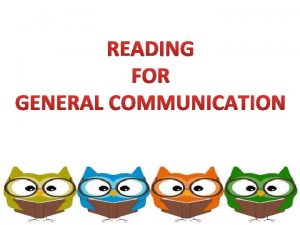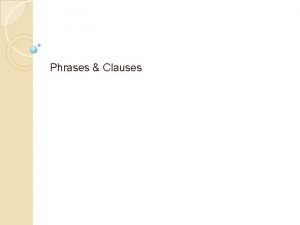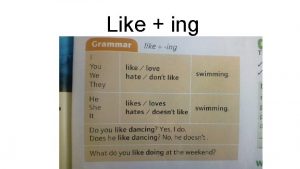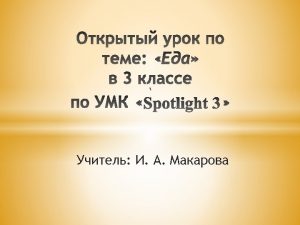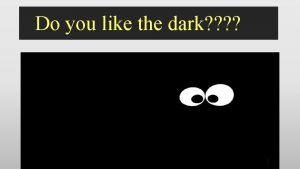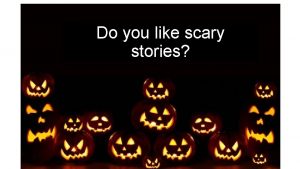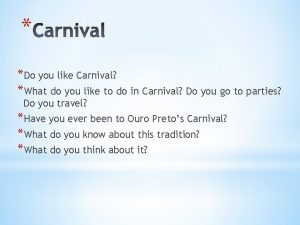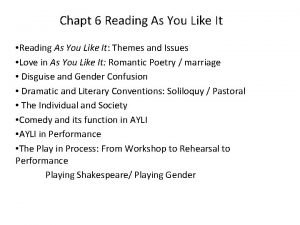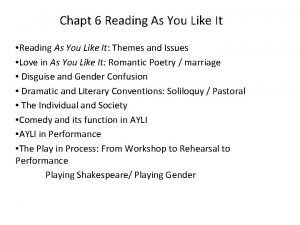READING FOR GENERAL COMMUNICATION Do you like reading

















- Slides: 17

READING FOR GENERAL COMMUNICATION

Do you like reading? What kind of books do you like most? How long do you spend time for reading a day? What motivates you to read?

READING IS. . . . The process of looking at a series of written symbols and getting meaning from them.


• For pleasure • To get the main idea of an information (read newspaper) • To locate specific information (date, term) • To learn the information (reading to learn) • To synthesize informatiom from multiple text (evaluate information) • To get general comprehension (reading to understand main idea and supporting information) Grabe, et al (2016)

Popular • • • Fiction Leisure Informal No reference list Widely available Broad audience Entertainment Subjective Commercial Vs Academic • • Non-fiction Research/education Sources cited Specialist outlets Specialist audience Theory Objective Non-commercial/private

How do you read the following? • Newspaper • Novel • Textbook • Journal article

Reading Strategies • Skimming • Scanning • Intensive Reading

• This course covers some basic reading skills for reading texts e. g. guessing the meaning, findings topic and main ideas, finding purpose of a text, etc. • Practices on using the skills will be explored in the exercises that follow the texts. • This course also encourages students to develop their reading habits

• Comprehend texts • Apply reading comprehension skills • Practice reading faster with good comprehension • Develop reading habits

Materials Syllabus 1 Course overview 2 Guessing the meaning of new words 3 Finding main ideas 4 Understanding Pronoun 5 Understanding punctuation 6 Making notes 7 Recognizing word forms 8 MID-TEST 9 Previewing Reading 10 Finding purpose 11 Using topic sentence to preview 12 Finding Details 13 Previewing Reading & infinitives of Purpose 14 Using topic sentence to preview & finding details 15 16 Review all of material FINAL TEST

Book Source: Hartmann, Pamela. 2007. Quest Intro: Reading & Writing. New York: Mc. Graw Hill.

• • • Attendance Classroom participation Quizzes Mid-test Final test : 10% : 20 % : 25% : 35%

1. 2. 3. 4. 5. 6. 7. 8. 9. Work in group of 6 – 8 Make a small circle Read the given text Draw four picture that can represent the text Switch your picture with the other groups Rewrite the story based on the picture Act it out. . Make sure every member in your group have a role The group with a highest score wins

The Boy Who Cried Wolf Once upon a time there was a shepherd boy who looked after the sheep in the hills near his village. He thought his job was very boring. One day, while he was sitting under a tree, he had an idea. He decided to have some fun, so he went down to the village and shouted ‘Wolf!’ at the top of his voice. As soon as the villagers heard the boy, they stopped work and raced to the hills to help him. But when they got there, they saw nothing. They returned to their work. After they’d gone, the shepherd boy smiled to himself. A few days later, the boy did same thing again. Her ran into the village and shouted ‘Wolf!. The villagers didn’t know whether to believe him or not, but they were worried about their sheep, so they had to help him. They went back to the hills. Again there was no wolf. They were angry because the shepherd boy had lied again, but he just laughed. Then, the next day, just before the sun was setting, a wolf really did appear, and it began attacking the sheep. In terror, the boy raced down the hill to the village, shouting ‘Wolf!’. Although the villagers heard his cries, they did nothing to help. This time they really didn’t believe him. The shepherd boy climbed up the hill to look for the sheep, but the wolf had killed them all. He was so ashamed of himself that he sat down in the moonlight and cried.


Materials Syllabus 1 Course overview 2 Guessing the meaning of new words Unit 1 Page 8 3 Finding main ideas Unit 1 page 10 4 Understanding tones Unit 2 page 32 5 Understanding pronoun Unit 3 page 68 6 Understanding punctuation Unit 3 page 69 7 Making notes Unit 3 page 90 8 MID-TEST 9 Recognizing word forms Unit 4 page 97 10 Previewing Reading Unit 5 page 124 11 Finding purpose/recognizing key word Unit 6 page 149 12 Using topic sentence to preview Unit 6 page 150 13 Finding Details Unit 6 page 154 14 Previewing Reading & infinitives of Purpose Using topic sentence to preview & finding details FINAL TEST 15 16
 Reading for general communication
Reading for general communication Remo ualberta
Remo ualberta While reading activities
While reading activities You thought i was like you
You thought i was like you Whats a clause
Whats a clause Plaster in american english
Plaster in american english Kontinuitetshantering i praktiken
Kontinuitetshantering i praktiken Novell typiska drag
Novell typiska drag Nationell inriktning för artificiell intelligens
Nationell inriktning för artificiell intelligens Vad står k.r.å.k.a.n för
Vad står k.r.å.k.a.n för Shingelfrisyren
Shingelfrisyren En lathund för arbete med kontinuitetshantering
En lathund för arbete med kontinuitetshantering Underlag för särskild löneskatt på pensionskostnader
Underlag för särskild löneskatt på pensionskostnader Tidböcker
Tidböcker A gastrica
A gastrica Vad är densitet
Vad är densitet Datorkunskap för nybörjare
Datorkunskap för nybörjare Tack för att ni lyssnade bild
Tack för att ni lyssnade bild
